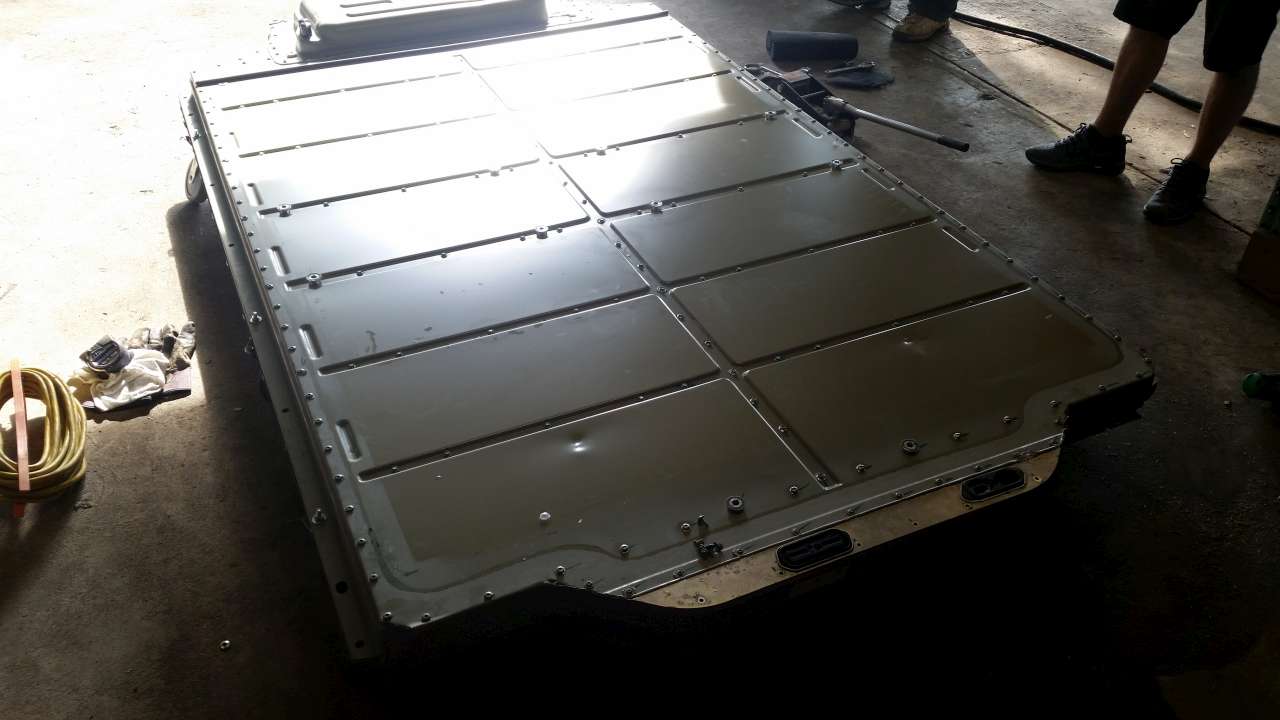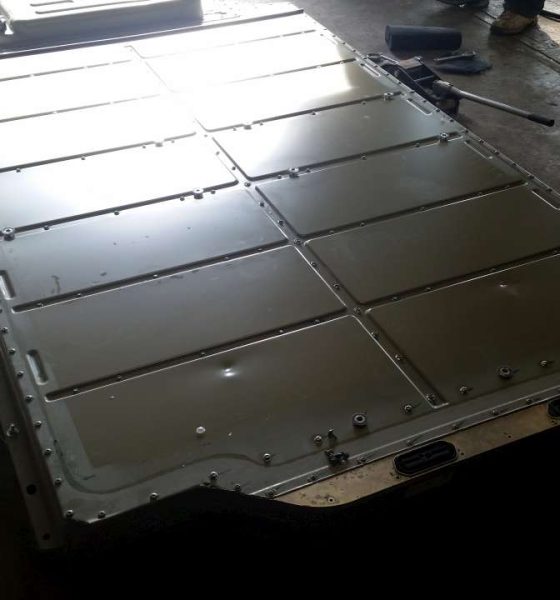

News
Tesla battery researchers open path to all-electric range extender concept
Tesla has solidified itself as an industry leader when it comes to electric vehicles and their range. However, an EV’s range could always be improved, and the company has taken great efforts to make this possible. One of these was outlined by Tesla’s battery researchers, who recently published the results of a test that cycles lithium metal on graphite to form hybrid lithium-ion/lithium metal cells. This particular innovation could open the door to an all-electric range extender.
Other automakers have used range extenders in the past, but they’ve been comprised of small petrol-powered engines that are used as a generator to recharge the vehicle’s battery pack when it is low on range. The process of cycling lithium metal on graphite, on the other hand, could lead to a 20% higher energy density than the traditional lithium-ion cells that power the Tesla’s vehicles.
Tesla’s battery research team, led by Jeff Dahn of Dalhousie University, has found a way to create a range extender of sorts without having to keep a small gas engine in the vehicle. Tesla detailed its findings in a research paper that was published to ScienceDirect on April 30. Titled “Cycling Lithium Metal on Graphite to Form Hybrid Lithium-Ion/Lithium Metal Cells,” Dahn and his researchers outlined the testing process.
The findings proved a possible 20% increase in range when using the range extender, which is comprised of “hybrid cells” that use Lithium-Ion and Lithium Metal. The cells also used an optimized electrolyte, and pressure enabled reversible plating on graphite.
The paper states:
“A hybrid anode cell design is proposed involving lithium metal plating on top of graphite that provides a 20% increase in energy density over conventional lithium-ion cells. Pouch cells with hybrid graphite-lithium metal anodes cycled with conventional electrolytes fell below 80% capacity in under 15 cycles. However, with a dual-salt electrolyte and applied mechanical pressure optimized for lithium metal cycling, hybrid cells achieved over 150 full (100% utilization) cycles before falling below 80% capacity with a CE of 99.6% for lithium metal plating on graphite.
“We also found that intermittent high energy (100% utilization) cycles utilizing lithium metal can be dispersed among hundreds of conventional lithium-ion cycles where only the graphite is utilized. Operating the cell with this intermittent protocol shows minimal impact to the underlying graphite capacity. Therefore, these hybrid cells can operate well in “lithium-ion mode” with periodic high energy full cycles accessing the lithium metal capacity.”
Tesla’s new findings show that increased energy density is made possible with the hybrid concept. When combining lithium-ion cells with lithium metal, energy density improves as the graphite anode utilized in traditional lithium-ion cells is not capable of handling the increased energy. The utilization of a dual-salt electrolyte also increases density and decreases battery cell degradation.
Tesla’s battery researchers described the advantages of the hybrid lithium-ion/lithium metal cells in the discussion below.
“If an electric vehicle with a conventional lithium-ion battery can deliver a range of 400 km, then hybrid cells could enable a range of 480 km. By capping the upper cut-off voltage of hybrid cells to operate in lithium-ion mode, the average cell voltage and delivered capacity will decrease. As a result, operating a hybrid cell in lithium-ion mode delivers an energy density of 530Wh/L, about 25% less than a conventional lithium-ion cell.
“This would result in a range of 300 km. In a study of driving behavior for EVs, Smart et al.34 showed that only 1% of daily trips are longer than 325 km on average. Therefore, operating hybrid cells most of the time in lithium-ion mode enabling a range of 300 km, while periodically using the lithium metal portion for long > 400 km trips, as mimicked by this testing protocol, should be viable for most drivers.”
It should be noted that the Tesla battery researchers’ study is only in their initial stages. Thus, it may take some time before the technology gets rolled out to Tesla’s fleet. The wait would likely be worth it though, as the hybrid cells could open the door to all-electric vehicles with range extender features. This would be incredibly useful for electric vehicle owners who take long road trips with family, and it could also be a notable step towards EVs gaining range parity with their petrol-powered counterparts.

News
Tesla starts showing how FSD will change lives in Europe
Local officials tested the system on narrow country roads and were impressed by FSD’s smooth, human-like driving, with some calling the service a game-changer for everyday life in areas that are far from urban centers.

Tesla has launched Europe’s first public shuttle service using Full Self-Driving (Supervised) in the rural Eifelkreis Bitburg-Prüm region of Germany, demonstrating how the technology can restore independence and mobility for people who struggle with limited transport options.
Local officials tested the system on narrow country roads and were impressed by FSD’s smooth, human-like driving, with some calling the service a game-changer for everyday life in areas that are far from urban centers.
Officials see real impact on rural residents
Arzfeld Mayor Johannes Kuhl and District Administrator Andreas Kruppert personally tested the Tesla shuttle service. This allowed them to see just how well FSD navigated winding lanes and rural roads confidently. Kruppert said, “Autonomous driving sounds like science fiction to many, but we simply see here that it works totally well in rural regions too.” Kuhl, for his part, also noted that FSD “feels like a very experienced driver.”
The pilot complements the area’s “Citizen Bus” program, which provides on-demand rides for elderly residents who can no longer drive themselves. Tesla Europe shared a video of a demonstration of the service, highlighting how FSD gives people their freedom back, even in places where public transport is not as prevalent.
What the Ministry for Economic Affairs and Transport says
Rhineland-Palatinate’s Minister Daniela Schmitt supported the project, praising the collaboration that made this “first of its kind in Europe” possible. As per the ministry, the rural rollout for the service shows FSD’s potential beyond major cities, and it delivers tangible benefits like grocery runs, doctor visits, and social connections for isolated residents.
“Reliable and flexible mobility is especially vital in rural areas. With the launch of a shuttle service using self-driving vehicles (FSD supervised) by Tesla in the Eifelkreis Bitburg-Prüm, an innovative pilot project is now getting underway that complements local community bus services. It is the first project of its kind in Europe.
“The result is a real gain for rural mobility: greater accessibility, more flexibility and tangible benefits for everyday life. A strong signal for innovation, cooperation and future-oriented mobility beyond urban centers,” the ministry wrote in a LinkedIn post.
News
Tesla China quietly posts Robotaxi-related job listing
Tesla China is currently seeking a Low Voltage Electrical Engineer to work on circuit board design for the company’s autonomous vehicles.

Tesla has posted a new job listing in Shanghai explicitly tied to its Robotaxi program, fueling speculation that the company is preparing to launch its dedicated autonomous ride-hailing service in China.
As noted in the listing, Tesla China is currently seeking a Low Voltage Electrical Engineer to work on circuit board design for the company’s autonomous vehicles.
Robotaxi-specific role
The listing, which was shared on social media platform X by industry watcher @tslaming, suggested that Tesla China is looking to fill the role urgently. The job listing itself specifically mentions that the person hired for the role will be working on the Low Voltage Hardware team, which would design the circuit boards that would serve as the nervous system of the Robotaxi.
Key tasks for the role, as indicated in the job listing, include collaboration with PCB layout, firmware, mechanical, program management, and validation teams, among other responsibilities. The role is based in Shanghai.
China Robotaxi launch
China represents a massive potential market for robotaxis, with its dense urban centers and supportive policies in select cities. Tesla has limited permission to roll out FSD in the country, though despite this, its vehicles have been hailed as among the best in the market when it comes to autonomous features. So far, at least, it appears that China supports Tesla’s FSD and Robotaxi rollout.
This was hinted at in November, when Tesla brought the Cybercab to the 8th China International Import Expo (CIIE) in Shanghai, marking the first time that the autonomous two-seater was brought to the Asia-Pacific region. The vehicle, despite not having a release date in China, received a significant amount of interest among the event’s attendees.
Elon Musk
Elon Musk and Tesla AI Director share insights after empty driver seat Robotaxi rides
The executives’ unoccupied tests hint at the rapid progress of Tesla’s unsupervised Robotaxi efforts.

Tesla CEO Elon Musk and AI Director Ashok Elluswamy celebrated Christmas Eve by sharing personal experiences with Robotaxi vehicles that had no safety monitor or occupant in the driver’s seat. Musk described the system’s “perfect driving” around Austin, while Elluswamy posted video from the back seat, calling it “an amazing experience.”
The executives’ unoccupied tests hint at the rapid progress of Tesla’s unsupervised Robotaxi efforts.
Elon and Ashok’s firsthand Robotaxi insights
Prior to Musk and the Tesla AI Director’s posts, sightings of unmanned Teslas navigating public roads were widely shared on social media. One such vehicle was spotted in Austin, Texas, which Elon Musk acknowleged by stating that “Testing is underway with no occupants in the car.”
Based on his Christmas Eve post, Musk seemed to have tested an unmanned Tesla himself. “A Tesla with no safety monitor in the car and me sitting in the passenger seat took me all around Austin on Sunday with perfect driving,” Musk wrote in his post.
Elluswamy responded with a 2-minute video showing himself in the rear of an unmanned Tesla. The video featured the vehicle’s empty front seats, as well as its smooth handling through real-world traffic. He captioned his video with the words, “It’s an amazing experience!”
Towards Unsupervised operations
During an xAI Hackathon earlier this month, Elon Musk mentioned that Tesla owed be removing Safety Monitors from its Robotaxis in Austin in just three weeks. “Unsupervised is pretty much solved at this point. So there will be Tesla Robotaxis operating in Austin with no one in them. Not even anyone in the passenger seat in about three weeks,” he said. Musk echoed similar estimates at the 2025 Annual Shareholder Meeting and the Q3 2025 earnings call.
Considering the insights that were posted Musk and Elluswamy, it does appear that Tesla is working hard towards operating its Robotaxis with no safety monitors. This is quite impressive considering that the service was launched just earlier this year.








